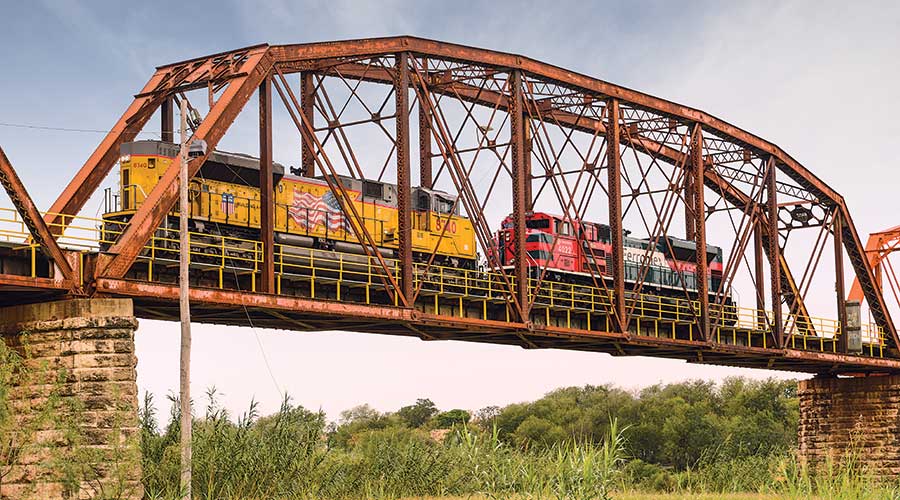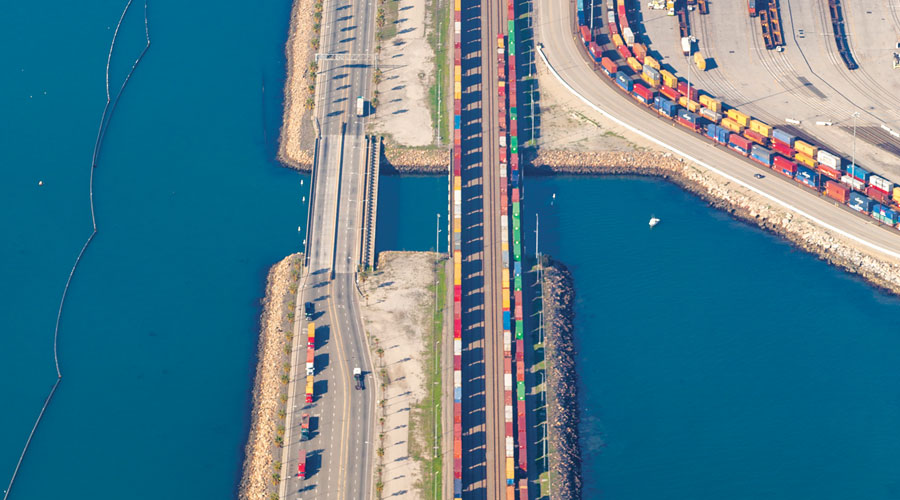Stay updated on news, articles and information for the rail industry
July 2022
Rail News: Canadian National Railway - CN
Class I railroads expect intermodal boost after several disruptive supply-chain kinks smooth out
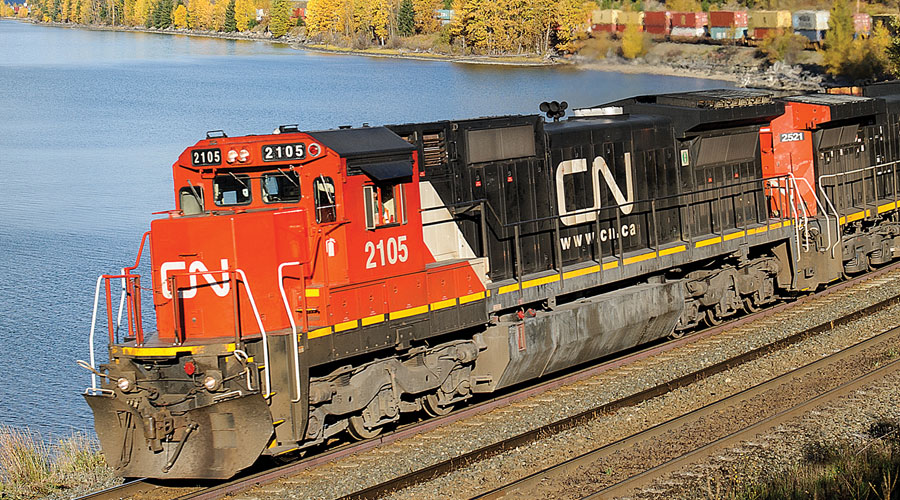
By Jeff Stagl, Managing Editor
Similar to the massive fluctuations in the U.S. stock market over the past few months, there have been colossal highs and lows in the North American intermodal sector of late. The developments impacting Class Is can be divided into good, bad and ugly categories.
The good:
• Demand is very strong since retailers continue to stock up to keep up with consumers’ frenzied online and in-store purchases.
• Intermodal has become a more compelling value proposition due to supply-chain constraints.
• Rail now is generally a cheaper modal option because of truckers’ struggles with a severe driver shortage, tight capacity and sky-high fuel prices.
• Furthermore, Class Is are landing more business-development wins, forging additional partnerships with truckers, ports and other stakeholders, and working closer with shippers and constituents to better understand global supply-chain shifts.
The bad:
• COVID-19 continues to impact supply chains, cargo mix and ocean vessel timing/reliability, causing import-crippling industrial lockdowns in China that began to ease last month, but then were reinstituted.
• Many U.S. ports are addressing serious congestion issues while major West Coast ports in Los Angeles and Long Beach, California, are dealing with a longshoremen contract that was set to expire July 1 unless negotiations led to a new pact.
• Understaffed distribution centers and warehouses are struggling with fluidity.
• Plus — adding fuel to the fire — rail equipment availability/usage is imbalanced because containers heading inland aren’t being promptly unloaded and returned to terminals.
And the ugly:
• Class Is continue to deal with a detrimental labor shortage, leading some large roads to turn away freight.
• Although showing signs of improvement since the first quarter, Class Is’ service performance still isn’t coming close to meeting shippers’ transportation needs.
• A detrimental chassis shortage — which could last into 2023 — is causing containers to dwell longer at terminals and hampering efforts to move them efficiently from Point A to Point B.
• In addition, the ongoing war between Russia and Ukraine continues to significantly impact global supply chains.
Although these developments mostly read like a disheartening chain of events, it doesn’t necessarily mean Class Is are discouraged about their intermodal prospects. Soft international volume so far in 2022 notwithstanding, they are quite bullish about increasing traffic and revenue in the sector through this year and beyond, especially domestic business. The primary reason: untapped growth potential.
“It’s an exciting time in intermodal. There are opportunities out there,” says CSX Vice President of Intermodal and Automotive Maryclare Kenney. “Demand is strong for the intermodal product.”
Strong enough that Canadian Pacific set a sixth-straight quarterly record for domestic volume in Q1. As CP officials put it, the Class I is “clicking on all cylinders” as it helps customers restock store shelves across Canada and reacts to changing truck market demand.
Norfolk Southern Railway’s domestic intermodal business in 2022 so far has exceeded expectations, says Shawn Tureman, the Class I’s VP of intermodal and automotive marketing.
Efforts to build partnerships, improve service reliability and exploit the Class I’s network — which serves 60% of the U.S. population — have enabled NS to double its intermodal franchise since the late 1990s. Another doubling seems doable over time, Tureman believes.
“Intermodal is a long-running story that grows and accelerates. We have a strong franchise,” he says.
A North American intermodal volume forecast tells the current story about Class Is’ growth potential. Although volume fell 6.6% in Q1, it’ll likely grow about 1% for all of 2022, the Intermodal Association of North America (IANA) predicts.
There are no clear signs of a freight recession. The ongoing addition of container capacity service routes and manpower in the intermodal sector bodes well for a bump in total volume, IANA officials believe.
Full-year domestic and international container volumes are anticipated to rise 6.4% and drop 2.8%, respectively, compared with 2021 levels. A greater share of imports will flow to East and Gulf coast ports, and a larger amount of transloaded freight will move in domestic containers off the West Coast, association officials project.
“Those growing transloads, and a steady share with tight trucking conditions, should boost domestic container volume,” IANA’s Q1 intermodal market report — which was released in early April — states. “Domestic loads should also grow from conversions from trailer traffic where carriers have expanded their domestic container fleets.”
Hire, then fire on all cylinders
But to realize that intermodal traffic forecast and capitalize on rail’s strengths, Class Is need to straighten out their serious workforce, service performance and equipment availability problems.
In terms of workforce challenges, CSX’s annual attrition rate has jumped from 7% to 10%. Despite accelerated hiring efforts, the Class I mostly has been able to replace only those workers during the pandemic. The railroad currently employs about 6,700 train and engine (T&E) employees and needs 300 more.
A lack of manpower is the reason CSX is ceding some cargo to trucks, President and CEO James Foote admitted during an AllianceBernstein Holdings LP conference on June 2.
“How much business are we missing? Lots. We’re not doing the job we should be doing,” he said.
Union Pacific Railroad also is trying to build its T&E workforce and take on more freight. About 300 recruits recently completed training and graduated while another 530 recruits remain in training, says UP Executive VP of Marketing and Sales Kenny Rocker.
The Class I has improved its onboarding processes, transitioned to more virtual interviews to reach out to a higher number of people at one time, trimmed training from 17 weeks to 14 weeks and leaned harder on its employee referral program to help with recruiting workers, he says.
UP also is embracing a Second Chance Program, through which the Class I will consider hiring people who have been formerly incarcerated, in recovery, or whose life choices and situations have impeded them from obtaining stable employment. Since launching a pilot program in Houston in December 2021, more than 70 Second Chance applicants have entered the hiring pipeline, Rocker says.
Each candidate is reviewed by a committee and assessed according to necessary skills and abilities. The program has been expanded to Chicago, Los Angeles, San Antonio, San Francisco, Seattle and Omaha, Nebraska, and other potential locations are under analysis.
“We want to give people who were incarcerated for a non-violent crime a second chance for a job,” says Rocker.
Fluidity, consistency main factors
UP and the other Class Is also want better service execution, which will help them provide truck-like reliability for intermodal customers.
That means focusing less on what they can’t control — such as congested distribution centers and warehouses — and more on what they can, primarily their slow networks.
UP is working to increase consistency, reliability and speed. Since mid-April, car velocity is up 6% and train speed is up 4%, says Rocker.
In addition to the expanded hiring effort, the Class I changed transportation plans to get more cars on a train, added locomotives and improved equipment to help bolster service.
For NS, more fluid operations hinge on a new TOP|SPG operating plan (meaning Thoroughbred Operating Plan|service, productivity and growth) that was launched in late June and will be gradually implemented throughout 2022.
Part of NS’ effort to become more customer-centric and operations-driven, TOP|SPG guides the day-to-day movement of trains and shipments network-wide to better serve changing customer needs and consumer demands. Shipments will travel more directly with a one-market origin to one-market termination.
While a previous TOP21 operating plan concentrated on merchandise and bulk traffic, TOP|SPG primarily will focus on intermodal. The new plan — which also addresses the auto and unit-train networks — aims to make daily operations simpler, more consistent and executable.
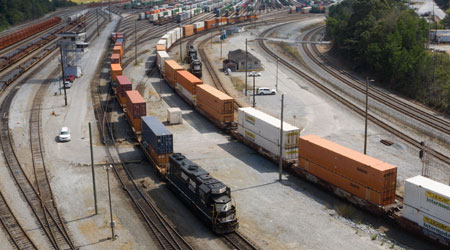
As part of TOP|SPG, NS plans to rework its intermodal operations to enhance service and improve network fluidity. The plan is designed to balance the flow of shipments through terminals, intermediate yards and the overall network; eliminate choke points; reduce work events; make better use of facilities; and realign train schedules to improve network velocity. The idea: to foster the right mix of motive power and train crews so terminals are fluid, assets spin faster and capacity is created for growth.
There are opportunities to capture more freight, and it comes down to operational fluidity and efficiency, says NS’ Tureman.
“Consistency and execution are more important than speed to market,” he says. “TOP|SPG will set us up to be more consistent and competitive in the marketplace for the next five, 10 and 20 years.”
At CSX, efforts to reduce dwell time have borne fruit this year. In addition, the Class I’s on-time performance — which is measured to the minute — now is in the low-90 percentages versus 87% in Q1.
“The goal is to be in the upper 90s,” Kenney says.
Even when things got dicey for CSX operations-wise in 2021 because of the pandemic and supply-chain issues, the railroad never closed any of its intermodal terminals, says Kenney.
“We have supported intermodal well, and customers recognize that,” she says.
CP’s intermodal customers have witnessed fluidity through 2022’s first five months despite some severe winter weather. The principles of precision scheduled railroading dovetail with what makes intermodal work, Coby Bullard — CP’s VP of sales and marketing, merchandise, ECP, intermodal and automotive — shared in an email.
“We need to offer regular on-time departures and execute against our schedules through good railroading day in and day out. We have an excellent record of delivering exactly that,” his email states. “We will maintain it through … operating discipline.”
At CN, international and domestic intermodal volumes are up so far in Q2 versus Q1, when extreme cold and snowy weather impacted much of the railroad’s western Canadian network. Temps plummeted in about 85% of winter’s days.
Train length and velocity are heavily impacted by such cold, so CN needed to use more crews and locomotives to move the same amount of goods. The railroad has experienced a much better operating environment in Q2 and now is intensely focusing on velocity, CN officials said in an email.
Chassis: ‘Need every one’
In addition to weather and labor, an ongoing chassis shortage has greatly impacted Class Is’ operations. A type of semi-trailer designed to securely transport a container, chassis are used by trucking partners to help railroads move containers between ports, rail yards, container depots and shippers’ facilities.
CSX is working with its chassis partner on boosting production capacity, says Kenney.
“If the supply chain improves, that would help the chassis supply, too,” she says.
UP has purchased 6,000 chassis, and some have already been delivered.
“We need every one of them,” says Rocker, adding the railroad perhaps would not have bought as many chassis if not for the drastic shortage.
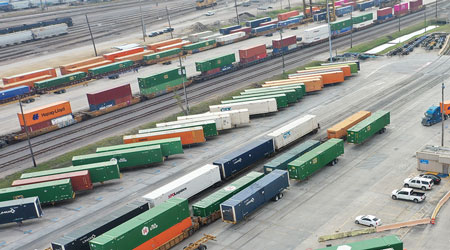
Ditto for NS, which plans to acquire “a significant number” of chassis in both 2022 and 2023 to support its business and volume growth, says Tureman. Certain customers, such as J.B. Hunt Transport Services Inc., also are investing in intermodal equipment, he adds.
There are myriad other ways Class Is are striving to show they’re vested in intermodal — many of which are recent — such as through additional partnerships, better services and improved infrastructure:
• BNSF Railway Co. launched a joint effort with J.B. Hunt through which Hunt will add supporting chassis based on market need and BNSF will bolster its rail-car equipment and provide several properties around key intermodal hubs in southern California, Chicago and other key markets to increase terminal efficiency. BNSF also advanced planned track efficiency improvements at its San Bernardino, California, intermodal terminal.
• CN proposed creating the Kansas City Speedway if the Surface Transportation Board requires CP and Kansas City Southern to divest a line from Kansas City, Missouri, to Springfield and East St. Louis, Illinois, as part of their proposed merger. Under new ownership, the line would ensure customers — particularly intermodal and automotive shippers — would have greater competitive shipping options between eastern Canada, Detroit, Chicago and Kansas City, and would help reduce highway congestion, CN officials believe. In addition, CN increased transload business on Canada’s West Coast and anticipates more East Coast transload opportunities in Halifax.
• CP worked closely with U.S. Customs and Border Protection to open a “live lift” pad in Jackman, Maine, that enables the railroad to remove individual containers for customs inspection, reducing delays for other containers on a train. The pad is modeled after a successful station the Class I opened in Portal, North Dakota, in 2017. CP also worked with the Canadian federal and New Brunswick provincial governments to obtain funding to triple capacity at Port Saint John and improve rail infrastructure along the New Brunswick Southern Railway — needs driven by CP’s return to the Atlantic Canada region through the acquisition of the Central Maine and Quebec Railway in 2020.
• CSX — which formerly provided regularly scheduled intermodal services at the Port of Montgomery — will serve a new intermodal container transfer facility the Alabama Port Authority plans to build there, and completed its acquisition of Pan Am Railways Inc., which will expand the Class I’s reach into the U.S. Northeast, including for intermodal movements. In addition, CSX in April began building a more than $25 million 63rd Street intermodal container storage yard in Chicago that — when completed in December — will provide additional options for manufacturers and distributors throughout the region, and enhance its container storage capability for operations at the 59th Street and Bedford Park intermodal terminals.
• NS recently partnered with UP, Hapag-Lloyd and the Port of Virginia to launch OceaNS Bridge Express, a new expedited intermodal service from East Coast origins to western U.S. destinations aimed at providing shippers a new option to reach West Coast markets. NS also added five new diesel-electric hybrid overhead gantry cranes at its Lander’s intermodal terminal in Chicago and Inman intermodal terminal in Atlanta.
• UP partnered with Swift Intermodal’s Knight-Swift Transportation division to handle all its container business as of 2022’s start, teamed up with intermodal service provider Schneider to serve as its exclusive western rail carrier beginning in 2023 and earlier this year acquired the Precision Components Inc. transload facility in Phoenix through its Loup Logistics subsidiary.
Creative juices were crucial
The OceaNS Bridge Express service came together quickly, the result of shippers and carriers “thinking creatively about moving goods,” says NS’ Tureman. Pegged as a long-term intermodal service option, it’s a testament to staying close to customers, he adds.
The service is offered as a sustainable and effective coast-to-coast solution to the challenges shippers currently face at congested West Coast ports. The land bridge can help expedite transatlantic shipments from East Coast origins to consumer markets in the west via ports in Seattle and L.A., Long Beach and Oakland, California.
“It helps us balance our network, to also bring goods back to the east from the west,” says Tureman.
OceaNS Bridge Express is a good example of the optionality that intermodal shippers seek, says UP’s Rocker. UP also is high on a couple of other options it hopes will entice more shippers.
In the L.A. area, the Class I opened a pop-up Inland Empire Intermodal Terminal in June 2021. The facility targets the fastest-growing industrial warehousing region in California. About 2 million imports (measured in cargo capacity units) are trucked to the Inland Empire area annually.
The region is home to more than 625 million square feet of industrial warehousing space, which is equivalent to 15 million short- and long-haul truckloads of freight. UP now is offering an initial service at the terminal for freight heading to or from Chicago, but the facility’s footprint is undergoing an expansion this year and additional markets will continue to be added.
The Inland Empire provides opportunities for backhauls, says Rocker, adding the region’s first order of business though is straightening out lingering warehouse and distribution center congestion.
Longer market reach in Midwest
Meanwhile, a pop-up Twin Cities Intermodal Terminal UP opened in January 2021 in Minnesota also is being expanded in 2022, and soon will be able to handle 100,000 annual lifts. The facility extends the Class I’s market reach and provides shippers more efficient access to the railroad’s intermodal network, says Rocker.
While focusing on infrastructure and service to attract more business, Class Is also are concentrating on environmental, social and governance (ESG) efforts to build intermodal traffic.
“ESG is very big with shippers,” says CSX’s Kenney.
CP’s Bullard concurs.
“One trend we continue to see is our customers’ focus on the importance of sustainability,” he said. “Their shipping decisions are taking into consideration the reduction of emissions, which gives intermodal a competitive edge over long-haul trucking.”
CP continues to explore ways to reduce its carbon footprint, including its ongoing hydrogen locomotive project. The railroad is working to design and build North America’s first hydrogen-powered line-haul locomotive using fuel cells and batteries to power the electric traction motors.
Class Is need to keep making strides with their programs, approaches and operations because they anticipate an early peak shipping season that could drive additional intermodal business opportunities sooner. The season now is projected to start in late July/early August instead of in late August/early September.
Since Class Is’ networks rely so heavily on partners — from other railroads to logistics service providers to ports — interconnectedness and mutual fluidity are major factors when it comes to intermodal performance, says NS’ Tureman. It’s been mostly rough seas over the past several months due to the supply-chain and other issues, yet a smoother going is in the offing, he believes.
“I think it will be a fun ride,” says Tureman. “It’s been a stimulating ride so far, to say the least, but it will be more fun.”
Email questions or comments to jeff.stagl@tradepress.com.
Keywords
Browse articles on intermodal Class Is BNSF Railway Co. CSX CN Canadian Pacific Norfolk Southern Railway Union Pacific Railroad Intermodal Association of North America TOP|SPG J.B. Hunt Transport Services Inc. Swift Intermodal OceaNS Bridge ExpressContact Progressive Railroading editorial staff.


 LRW Honors Amtrak’s Acheson As Railway Woman Of The Year
LRW Honors Amtrak’s Acheson As Railway Woman Of The Year
 From Editor-In-Chief Foran: Of Gender Equity And Inclusion
From Editor-In-Chief Foran: Of Gender Equity And Inclusion
 Spotlight On Some Of Today’s Rail Safety Products
Spotlight On Some Of Today’s Rail Safety Products
 Women of Influence in Rail eBook
Women of Influence in Rail eBook
 railPrime
railPrime




